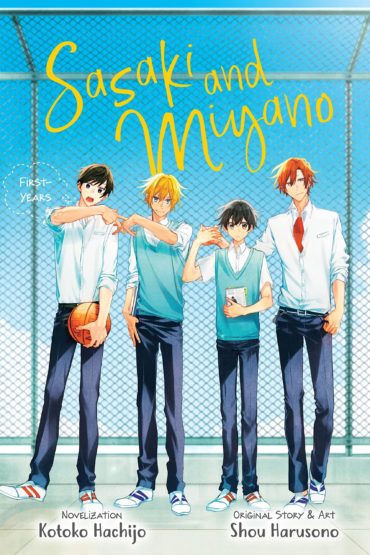Sasaki and Miyano First-Years Review
“I love the stars. My name is Taseku Kuresawa, and I’ve always been entranced by the night sky – by the heavens so filled with specks of light that it feels like nothing else exists between them and human life here on Earth. I knew that one way or another, my future would inevitably revolve around those stars.”
Taseku Kuresawa is a serious student with a passion for astronomy. In middle school he suddenly becomes intrigued by one of his classmates: Yuki Fujimi. When she’s hospitalized in their third year, he joins others from his class going to visit her in hospital and a spark ignites between them. She’s suffering from an as yet undiagnosed condition which means she has to spend frequent spells in hospital and Kuresawa, smitten, wants to do all he can to cheer her days, bringing her books (she’s a BL aficionado) and everyday chat about the everyday world that she’s missing out on. He’s just started high school and she’s fascinated by the fact he’s chosen an all-boys institution. But his feelings for her lead indirectly to a violent incident at school which has unanticipated consequences – not just for him but for his first-year classmate, Miyano, and a passing senior on after-school cleaning duty whom Miyano begs to help…
Then there’s Miyano and Kuresawa’s friend and classmate, lively Gonzaburo Tashiro, who’s somehow found himself a vital part of the school Ping Pong Club. The only way to get out of it is to challenge the club president to a match and defeat him! However, the resourceful Tashiro has a secret plan which can’t fail – or so he believes.
Spin-off fiction from popular manga and anime can be something of a mixed blessing, with writers sometimes missing the right tone of voice by a mile, making the end result a teeth-grinding read. Luckily, because of Kotoko Hachijo’s straightforward yet apt writing style, well translated for us by Kevin Steinbach for Yen On, this first volume acts as a welcome enrichment to Shou Harusono’s popular BL manga, where it could all too easily have sounded a ‘wrong’ note, going off on its own trajectory and losing what makes Sasaki and Miyano so unique. This stays faithful to the original material while also offering the reader some insightful glimpses into the minds of the main protagonists which enrich our understanding of their lives. Because, like the novel of Hirano and Kagiura, the text is filled with delightful full-page drawings by Shou Harusono, we’re constantly reminded of the mangaka’s presence – and there are also some welcome new 4-koma pages at the end.
Aw, it’s just a sweet and enjoyable read – if you’re already invested in the world of these boys. But if this is your first encounter, I’d recommend you read the manga first and then come back, because to the uninitiated reader, it’s probably going to be a little baffling. For example: that first chapter all about Taseku Kuresawa. Throughout the manga, Kuresawa, Miyano’s friend, has kept his beloved girlfriend a mystery from his classmates; all they know is that she’s more in than out of hospital with some unnamed illness/condition. For Hirano and Kagiura fans, there’s also a whole Pocky Game-based chapter which means a great deal more if you’ve read the recent manga and novel about the two sharing a dorm bedroom.
Just a side-note but this translation doesn’t use ‘senpai’ or ‘kouhai’ and Sasaki says ‘Miya’ to address Miyano, rather than ‘Mya-chan’ and Hirano calls Kagiura ‘Kagi’ rather than ‘Kagi-kun’ as in Yen Press’s edition of the manga. Different translators, different approaches, I guess.
“I liked to call him Miya. Yeah, it sounded silly, kind of like a girl’s nickname. And yeah, this was an all-boys school, so he was a boy too, but whatever! He’s just insanely cute.” Shumei Sasaki.
The introduction of Kuresawa’s girlfriend Yuki (there are even illustrations!) is probably the newest element in this collection. Each chapter in turn is narrated in the first person by one of the main characters, giving the whole a very natural flow and tone of voice, whether it’s Miyano or Sasaki, Hirano or Kagiura speaking. It’s an attractive embellishment of the early chapters of the main manga, yet apart from us getting to know more about Kuresawa’s girlfriend and how the two interact, there really isn’t anything else new here that hasn’t been alluded to already in the original story. Which doesn’t make it any less enjoyable for fans of the original series.
There are ‘afterwords’ from both Kotoko Hachijo and Shou Harusono which shed a little more light on the genesis of the project. Yen On have kept the trade paperback format that they’ve used for the Hirano and Kagiura novel but inside, like the manga, has an illustrated two-page contents list. There are also two cute colour pages at the beginning, with chibi versions of the main characters, and Shou’s Harusono’s cover art is as attractive as ever; the reverse cover is especially apt as it captures perfectly that ‘everyday life’ feel. The second volume, Sasaki and Miyano: Second-Years, is due out from Yen On in August 2023.


